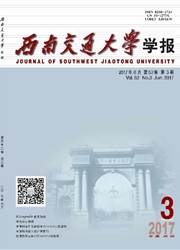

 中文摘要:
中文摘要:
为解决无站址备择情况下山区铁路车站自动选址问题,基于线站耦合约束要求及灰色关联分析理论,提出了“加权模板转换方法”.该方法首先将铁路车站站坪区域范围简化为一个给定长、宽的空间矩形模板,并通过移动、旋转该模板搜索车站站心位置(矩形模板中心)和站坪方向(矩形模板纵向中心线方向);然后建立以用地代价、土石方工程代价、与居民区距离、线站耦合程度为评价指标的评价体系,并基于灰色关联分析理论,计算各项评价指标权重;最后计算通过移动、旋转得到站址方案的综合代价,经排序比选实现连续空间内铁路站址的自动寻优.以我国西南山区某铁路为例对该方法进行了验证,验证案例共输出49个站址方案,并依据综合设站代价由小到大进行了排序,结果表明,该方法可在复杂山区环境下自动生成铁路站址方案,辅助设计人员进行车站选址设计.
 英文摘要:
英文摘要:
To solve the problem of automatically setting railway station locations in the case where no alternatives can be selected,a method named “weighted mask transform”was proposed. This method is based on the grey correlation analysis theory and the coupling between railway alignment and station locations. First, the range of the station area was simplified as a rectangular mask of a given length and width. The locations of station centers were searched by moving the rectangular mask,while the stations directions were determined by rotating the mask. Then, an evaluation system including land use cost, earthwork cost, distance from residential areas, and the coupling degree of railway alignment and station locations was established. The weights of these evaluation indicators were assigned using the gray correlation analysis. Finally, calculations and ranking of the comprehensive costs of the station locations, which are obtained by moving and rotating the rectangular mask, were carried out to realize the optimization of station locations in continuous areas. The effectiveness of the proposed method was verified by applying it in an actual railway station in the southwest mountainous areas of China. Forty- nine alternatives were generated and ranked from low to high according to the comprehensive cost. The result shows that the method can assist the designers by automatically generating optimized railway station locations in complex mountainous regions.
 同期刊论文项目
同期刊论文项目
 同项目期刊论文
同项目期刊论文
 期刊信息
期刊信息
